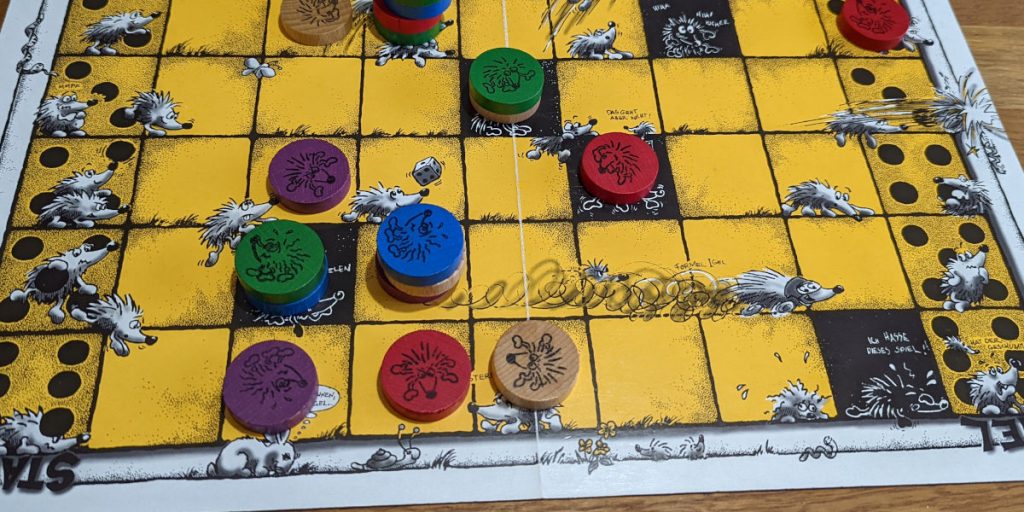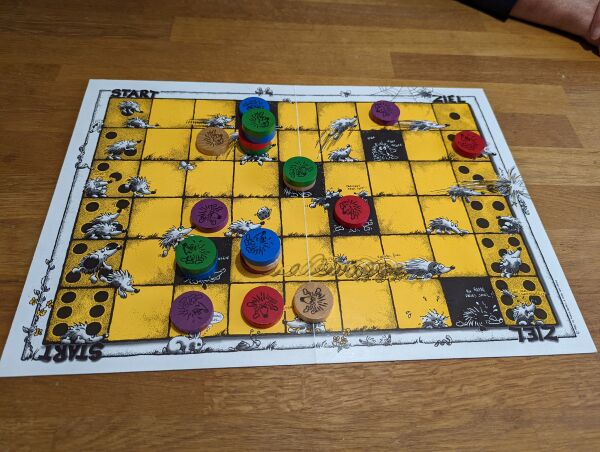Hedgehogs, Dogs and Mad Science

For the first time in almost two years we got together to play some boardgames. There were five of us, and we decided we wanted to start the year off with some relatively simple games that didn’t require too much thought or reading of rules.
We began with an old favourite of ours – Igel Ärgern, or as we call it (since we don’t speak German) Hedgehog Racing. It is one of my favourite boardgames, but is incredibly simple. Everyone has four tokens, and the first to get three of them to the far side of the board wins.

On your turn, you roll a D6 to see which column moves forward. If there’s a token (of any colour) in that column that can move, then you must move one token forward. Before you move though, you can side step one of your tokens to the left or right. If there’s a stack of tokens, only the token on top can move.
Some squares are ‘pits’, and if you go into a pit you can’t move out until all other hedgehog tokens have moved up level to you. So in the above photo, the pit in column 5 is free so hedgehogs can be moved out of it.
If the player with white hedgehogs rolls a 5, they could sidestep their hedgehog from column 6 into 5, then move it forward. Or they could move the blue hedgehog forward to free up their hedgehog stuck underneath it. If they had a hedgehog just before a bit, they may want to move it away from the pit so another player can’t move them into it.
And that’s pretty much the game. It’s simple and has quite a bit of randomness, but it does have tactics and it is fun and simple. I was red, and doing really well (I was first to get one token to the finish line), but then two of my tokens got put into pits.
Next up was another racing game – Snow Tails. This is a bit more complicated, with card based randomness. The aim of the game is to be first to get around the track with their dog sled. You need to navigate corners, avoid trees and try not to crash into other sleds.
It has quite a clever mechanic for movement. You have a hand of 5 cards, which are numbered 1 through 5. When you move, you play one or more cards onto either your two dogs, or onto your brake. You can play multiple cards as long as the numbers are all the same.

The total of the cards on the dogs, minus the number on your brake, tells you how many squares you move forward. If there’s an imbalance on the numbers on the dogs, then you also veer left or right. So if you have 2 on the left dog, 3 on the right dog, and 1 on your break, you move forward 4 squares, one of which has to be diagonally right.
You draw your hand up to five cards at the end of your turn, so you’re never guaranteed to have just the right numbers you need for your next go. If you take damage, then you get damage cards which can’t be played, so it reduces the number of options you have.

Trees are one time obstacles – if you run into a tree, you take a damage and the tree is knocked down, clearing the way for people behind. There are also places on the track (normally at the start of corners) where there is a speed limit. If you are going faster than that when you cross the line you take damage equal to how much faster you are going.
Though I spent a good proportion of the game out front, I came third in the end after getting into a couple of bad positions where I could only make it around corners by slowing almost to a stop.
Our third game was Nefarious, a game where everyone plays at being a Mad Scientist planning world domination through the invention of strange inventions. I felt that this was the weakest of the three games.

You start with some cash and three inventions, and each turn you select one of four actions – Espionage, Invent, Research or Work. Espionage allows you to select an action, and you get cash if one of your neighbours (player sitting to your immediate left or right) selects that action. Invent allows you to pay cash and play an invention. Research gives you 2 cash and allows you to pick up a new invention, and work gives you 4 cash.
You start with 10 cash, and all my inventions were in the high teens in terms of cost to invent, so I assumed there would be a lot of needing to build up cash to create inventions – hence my three red spies in the ‘Work’ action in the photo. Then everyone started creating inventions with costs of 2 or 4 and the game ended a lot quicker than I expected.
The game feels like it should be a lot more fun that it was. The inventions don’t really do much, except maybe give or take cash or inventions to players. They have some fun names, but these are just labels with no effect, so unless players roleplay what they’re doing then it’s all a bit flat.
There are twists played at the start of the game, which might change the rules slightly. The aim is to be the first to play inventions totalling 20 points – which probably means 3 to 6 inventions in most cases.